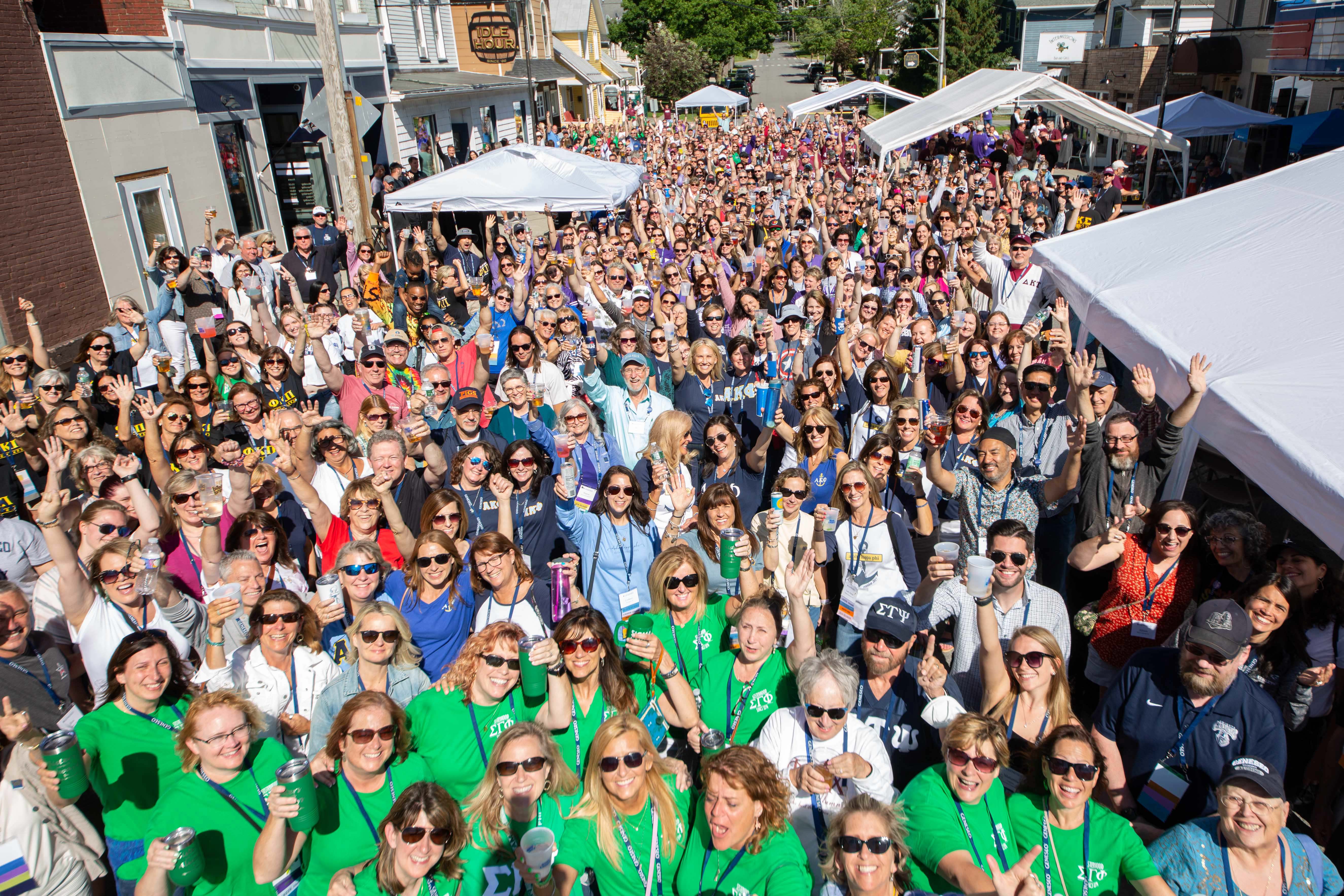Geneseo community members share how their pets teach them about life, loss, relationships and unconditional love.
By Kris Dreessen
A paw on the hand, a face full of fur, a loving greeting when we arrive. From dogs and cats to horses and pot-bellied pigs, our pets change our lives — and us — in large and small ways.

Geneseo President Denise A. Battles, Michael Mills and Vejovis. /Photo by Keith Walters ’11
President Denise A. Battles, Michael Mills and Vejovis: Pet ambassadors and accepting loss
We were just going to meet Vejovis, or as we call him, Vejo (pronounced Vay-ho), thinking about adopting another dog after our Texas Lucy passed. We drove to Connecticut to see him and ended up bringing him home.
Basenjis (an African barkless dog) are an uncommon breed and high maintenance. They are fast, high energy and bouncing off the walls. You need to take multiple walks with them each day. We liked to say that wherever Lucy was, she was the most walked dog in the community — because she was.
When we came to Geneseo, we discovered that our dog walks were a wonderful entree into our new community, on campus and in the village.
Lucy allowed us to form connections when maybe we wouldn’t have otherwise. A lot of times, students would run up to us and ask to pet Lucy, often because they were missing their own animals at home. She became so ingrained in the campus community that the resident assistants were asked during RA training what the name of the College president’s dog was. We were always together, a package deal.
When Texas Lucy passed last fall, the outpouring of support we received from the College and village helped us grieve and showed to us that she had truly been a part of the community. Afterward, the stories shared with us from well-wishers demonstrated how impactful the lives and loss of pets can be on so many people. It is often not until a pet is lost that you fully realize how integral they have become in your life.
Texas Lucy gave us so much and we still feel her absence. We were able to give her — a rescue dog — a good life, but we could hardly bring ourselves to say goodbye. There is a universality to loss and pain that owners feel when the time comes.
In many ways, our Vejo is much like Lucy was — an energetic rascal, getting into trouble and bounding away with a sock or tissue. His youth and happiness make us smile and shake our heads. When we have had a bad day, he seems to sense our need. It puts everything into perspective.
Vejo can never replace Lucy because they are so different, but his youth and vitality have invigorated our lives and helped us continue to heal. He’s a light in our lives, no doubt.
And he has taken to the village. He loves campus. We walk hours every day, all over the place. He’s going to be the most walked dog in Geneseo.

Meagan Mulcahy ’14 and Bacon. /Selfie by Meagan Mulcahy ’14
Meagan Mulcahy ’14 and Bacon: Responsibility and Friendship
Bacon is exactly what you might think a pig is — pig-headed. If she doesn’t want to do it, it’s not happening. As stubborn as this Vietnamese pot-bellied pig is, she’s very affectionate and wants to be where you are and know what you’re doing at all times. She likes to cuddle.
My sister and her now-husband originally got Bacon, and she came to live with us when he joined the U.S. Air Force and they went to live on base. She was as small as a football and so squealy. She’s a mini pig, but that’s a little deceiving. At 11, she’s nearly 200 pounds.
She’s part of the family. She spends most of her time in the house and sleeps in a dog bed in my parents’ bedroom. We built a pen for her in the back yard so she has her own little space. Pigs like to dig, so she can dig as many holes as she wants and not tear up the entire back yard.
Bacon is wildly intelligent, has a lot of feelings and is not afraid to communicate them with grunts and her nose. Nose down is disappointment and she uses that look to get sympathy. My dad calls her Eeyore when she does that. She also expresses when she doesn’t want us to leave — by blocking the door!
I consider her my niece because I’m equal parts playmate and caretaker. All pets love scratches and I am her groomer. I keep her face clean because she does all that digging with her nose and I’m also in charge of bath time. I coax her into the kiddie pool with grapes or carrots.
She is as close to me as my human friends. She has just as many emotions, which still floors me after more than a decade of living with her. Sometimes I come home and want to play and she’s not into it, just like any person. Without being able to communicate with words, she shows me how much she cares and appreciates me, every day.
It’s hard to imagine our household without her. With her, I’ve gained a lot of patience and experienced unconditional love.

Evan Goldstein ’17 and Jack, on the couch. /Photo by Kendall Fitzergerald ’17
Evan Goldstein ’17 and Jack: Open-heartedness and small magical moments
We adopted Jack last August when we were considering getting a dog but not actively looking. We saw his photo and just sort of knew. When we picked him up, he followed us into the street, jumped in the back seat of the car and wouldn’t get out.
I tutor high school students in Salt Lake City and work at a used bookstore that’s been open since 1968 and has a very long history of store dogs. Jack comes to work with me and greets every customer, sits and lets them pet him as long as they want. He understands the smallest cues and looks directly at them with his soft brown eyes. Some people come in after a long, hard day, and he sits with them and they start to breathe and you can see them let things go.
We must always be compassionate and open-hearted and not protect ourselves by closing ourselves off from other people. Watching him spend time with each stranger who comes into his life is a lesson in empathy.
We take Jack for walks and spend time with him on his scale — enjoying the sun and following scents — without rushing. In the alley behind our house, he stops to stick his head through the hole in a fence, and I notice how the grass has grown since yesterday or see small flowers, the footprints of deer and rabbits — things that show us how to live slowly, to be a child and watch the spring become summer.
Recently, we had the hottest day on record. Tonight, I’ll try to pass the body of a sparrow and he’ll pull me off the sidewalk to it. Helicopters will circle above the city. He’ll linger over traces of the animals that walk through the grass and live in the trees and I’ll linger with him, and look at the world we must defend.

Johnna Finster ’21 plays with her dogs. /Photo by Michelle Wolgast
Johnna Finster ’21 and Sadie, Remmie, Bella, Winnie, Tinkerbell and Ruth: Unconditional love and extended family
There’s a 1-to-1 ratio of dogs to people at my house. We have four dogs — Sadie, a golden retriever, is 8 months old. Remmie is another golden retriever. Winnie is a Bernese mountain dog, and Bella has three legs and came from Tennessee as a rescue.
I don’t know if she knows she has three legs, but she definitely has a harder time getting around. We do everything with her as the other dogs, but our walks are shorter.
We also have two cats, Tinkerbell and Ruth. Ruth just sort of walked into the house with the dogs one day and decided she was going to live with us. She jumped up on the counter and made herself at home. She chose us.
All the dogs sleep in my parents’ bed. A cat will sleep with me, or sometimes yell at me to let them out of my room in the night. In the morning, the dogs are all there waiting for me, jumping to see me, like “Oh my gosh! I have not seen you in forever!”
Six pets certainly keep life exciting. There is always something to do and always something going on. They don’t let it get boring. They can be stubborn, especially Bella. I feel like I can’t deal with her at times, but just like with people, you have to get along. They are just like siblings.
It has been rough lately, and when I’m feeling it, one of the dogs will run up to me and make sure I’m okay. They know when you are not exactly right, and they try to help fix it. That’s the best part. Bella will jump on you and lick you. Our Bernese is too big for that, so she leans in.
I have learned responsibility in taking care of all of them. They love you as much you love them. They are my other siblings. They are part of the family. We take care of them and they take care of us.

Annalee Bainnson ’19 and Ryley. /Photo by Udeshi Seneviratne ’19
Annalee Bainnson ’19 and Ryley: Confidence and nonverbal communication
I’ve had Ryley since I was 16. When I came to Geneseo, I brought her to a boarding farm so she was with me. If I was having a rough day, I could go to the barn and just jump on her and wander around the woods for a few hours, getting lost and being with my thoughts. There was a freedom to it.
I was never into team sports but as an equestrian, I do have a team — with my horse.
I’ve been riding since I was 7 and over the years, I have learned the importance of nonverbal communication to make that team successful. I can’t talk with Ryley, though I’m asking her to complete a complex jumping course and set of maneuvers. The way I hold the reins, my leg postures and the way I sit all tell Ryley what I want her to do. She’s a 1,200-pound creature. I have to be confident. She reacts to my mood. She feels it.
As a horse owner, you need to learn how to carry yourself and give orders nonverbally, so they understand and don’t take advantage of you, which, honestly, is useful for interpersonal relationships in the workplace. The way you carry yourself can have a huge impact on how others perceive you.
It’s given me a lot of confidence.
My ability to sense someone’s attitude and emotions has definitely been enhanced because I do it all the time with a creature that doesn’t talk. I worked as a horse veterinarian’s assistant, and during heavier, sadder times, when we had to put a horse down, the client would take us into the house and show us old photos of the horse, or cry on our shoulders. Other times, they were silent. I could sense what they needed.
I’m a photographer and that sense helps me tell when someone is uneasy in front of the camera, and I can slow down and work with them so they are comfortable.










